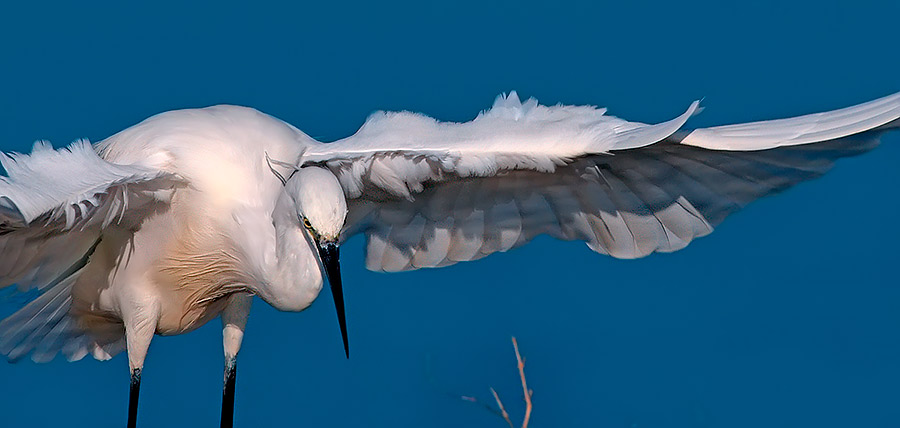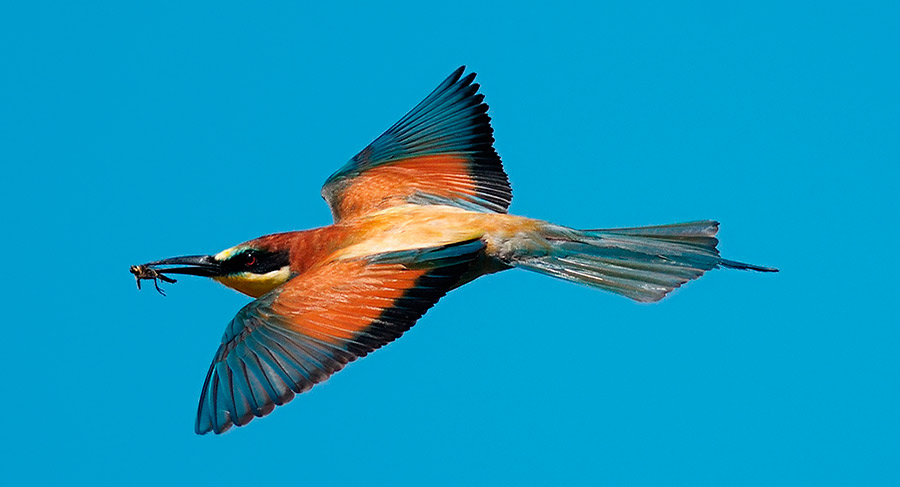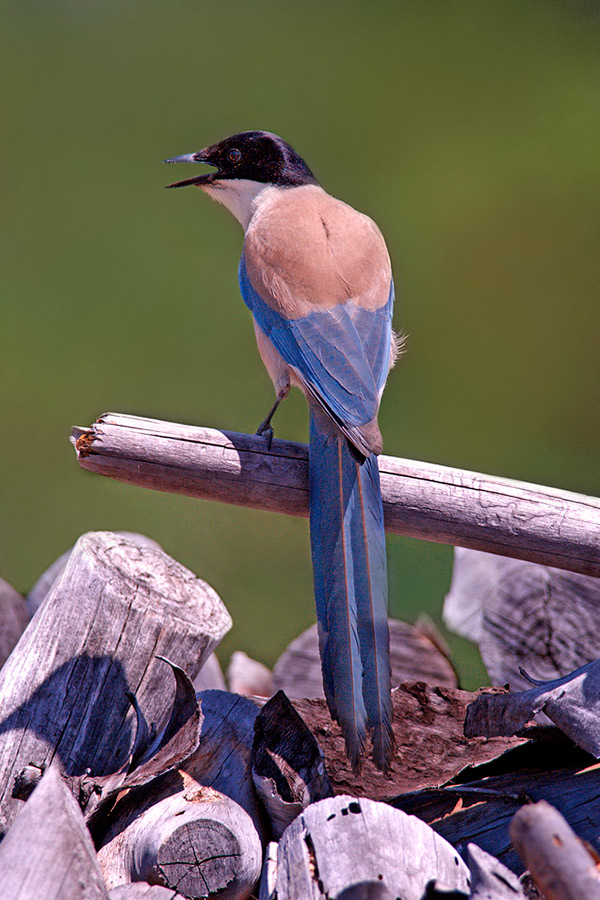
COTO DOŃANA - the Serengeti of Europe
by Alberto B. Scalia

|

Horses at woad in "the Madre de las Marismas" |
There are places that, in the imagination of each of us, represent the sum of emotions, passions and aspirations that a place on this planet could give. It could be, for example, the case of a backdrop of the Maldives for a diver, or Himalayas for a climber or even an African park for a wild animal lover. At the mouth of the Guadalquivir River, in southern Spain, in the beautiful region of Andalusia, there is one such place that is probably for the wildlife photographer, and in particular for what you interested in photography of birds, the sum of all the aspirations that he may have.
THE PARK
The park of the Coto Donana is one of the largest parks in Europe and covers the area of the mouth of the river Guadalquivir in a triangle between the cities of Seville, Jerez and Huelva. It is the second largest wetland complex in importance of Western Europe after the Waddensee (the stretch of coast from Holland to the Danish territory). The Coto Doñana is the largest protected area in Spain, a biosphere reserve by UNESCO and World Heritage Site since 1994. Established in 1978, consists of two distinct areas: the National Park which occupies an area of 50,174 hectares and the adjacent and namesake natural park (called Entorno de Doñana) of 53,709 hectares. The origin of the name of the park is to be traced back to the sixteenth century when the seventh Duke of Medina built a palace for his wife, Doña Ana Gomez de Silva y Mendoza. The surrounding lands soon took the name of Bosque Doña Ana or Coto de Doña Ana, until the name is contracted up to what we know today.
The Coto Doñana is a land of wide open spaces and of extreme contrasts: it is a bridge between Europe and Africa; It is sandwiched between the Atlantic and the Mediterranean. It is located between two continents and as such presents a quantitative and qualitative concentration of species unimaginable elsewhere. Almost half of the European bird species (of which about a hundred as many migratory and resident) for a sum of about six million of speicemen each year passes through these lands. Beyond what is of high importance to the presence of some species extinct elsewhere such as the Iberian lynx or the Spanish Imperial Eagle. It includes also extremely interesting animal species such as deer, wild boar, the otter, the wild cat, the polecat and Genet. A special case is that of the African Chameleon present in Europe only in these areas. Among amphibians, the Triton marbled, the midwife toad, the Natterjack Toad. Reptiles are well represented with species such as the ocellated lizard, the Greek tortoise, the Montpellier snake, the horseshoe Colubro, the Natrix viper, viper Lataste. |

the "Madre de las Marismas" is the largest brackish marshes perpetually flooded |
ENVIRONMENTS
As already mentioned the Coto Doñana is actually made up of two distinct areas: the National Park, strictly protected, which occupies the most precious and closest to the sea and the Natural Park or Entorno de Doñana, outside of the first zone to is the natural continuation, with less restrictive rules and where people are allowed to off-road. The natural environment, vast (over 100,000 hectares) has three main ecosystems:
The Cotos (the stable part of the park), a vast wasteland interspersed with cork trees, groves of pine, arbutus, ash. This is the kingdom of birds of prey (Imperial Eagle, Booted Eagle, Buzzard, Red Kite, Black Kite, White harrier, Kestrel etc), passerine birds (warblers, shrikes ect.)nnd rarities (Spotted Cuckoo, Red-necked Nightjar etc. .). Two special cases are those of Blue magpie found only here and in Portugal and found in Europe only in East Asia to more than 8,000 kilometers and the African chameleon present only in certain restricted areas of the park (the only site in Europe).
The Marismas, the intricate interweaving of salt marshes formed by the Guadalquivir and the other old arms of the river, lagoons, plains covered with salicornia, canals and reed beds. This is the environment in which concentrates the most species of birds, especially aquatic ones, some of which, especially in winter, are huge concentrations of individuals (70,000 wild geese, virtually all species of ducks with European tips 150,000 to 200,000 individuals, shorebirds with woodcock sea, Plovers and Grey Plovers, Curlews, Godwits real and common, Lapwings and a large number of passerines). Remarkable, in quantitative terms, the presence of the wintering of the Bittern, the Heron Egret and especially the White stork. And of course many wintering raptors and predators such as Peregrine falcons. In marismas they exist then a series of sub-estates essential to the life of the whole ecosystem of Doñana:
The Vetas raised areas, flooded and only in times of great floods and location of nesting shorebirds such as the Italian knights and Avocets. The lucios, the lower land, which remain completely flooded throughout the period of the favorite especially flamingos and avocets. The quebradas surface water available, constantly flooded and then the place of pasture ideal for waders. Finally the caños ie the natural channels that keep alive the marisma, a place beloved by the very rare Crested Coot and Purple Gallinule. Finally, the third ecosystem is represented by the beaches of mobile dunes, located between the sea and the marshes, on four fronts and wide up to 5 km, forever changing because of the sea and the wind that models pushing them towards the river that then it returns to the sea restarting the cycle. |

El Rocio, out of time village
|
THE VISIT AND FAUNA
I was lucky enough to visit this beautiful place obtaining sensations, emotions (and photographs) that I think will make me company for a long time. I state that I was a tourist trip with the family, so I could devote to the Park and to photography only two full days and one morning. Many of the things I've seen I have just been able to savor and many others I could not see them. I think, to experience its extreme nature, it is necessary not less than 7-10 days. And try to rent a space a car (preferably a true off-road), it is absolutely necessary. Otherwise, there are many local tour operators who organize various forms of safari Land Rover; But, apart from the fact that the costs are not exactly cheap, we know that the nature photographer is anarchic for excellence, and love to move freely and in their own time. However in the village of El Rocio work Discovering Doñana (www.discoveringdonana.com) founded by the Italian spouses Claudio and Marina Manetti you will experience the park "from the inside" as they like to tell them.
|

il caratteristico villaggio de El Rocio, proprio al
limte da la Madre de las Marismas centro di partenza obbligato
per una visita al Parco
|
EL ROCIO AND MOTHER DE LAS MARISMAS
To whom, however, he had organized the visit by its own means, recommend spending at least one day in the village of El Rocio. Here, among other things, there are some great hotels where you can stay although personally I would prefer to stay in the neighboring sea village of Matalascañas for several reasons. Meanwhile El Rocio is a village practically deserted for much of the year. It has no paved roads (in fact the sand is very fine) so if you are allergic or bothers the dust, it is not just the place for you. It is also right on the edge of marisma with obvious drawbacks due to humidity and mosquitoes. Conversely if you love the spartan holidays and have ability to adapt, this village will offer fantastic atmosphere and photographic moments. Suffice it to say that the "walk" of the village runs along the edge of the marsh and the benches of this walk, you can take pictures (at a 500 mm) waders and water of all kinds, red kites and brown (here truly ubiquitous) flamingos, black terns, herons, spoonbills and all other good things.
|

Godwits photographed from the promenade of El Rocio
|

The Pink flamingos give a splash of color to marisma
|

Little egret hounting
|
And if you want to live an unforgettable experience (and adrenaline) El Rocio will offer everything:
In fact, this country is known throughout Spain for a party that is held there: it is actually much more than just a party and is a ritual that sees conivolte thousands. During Semana Santa (saint week - which occurs in the first week of June), tens of thousands of gypsies from all over Europe gather here for a pilgrimage that has as its ultimate goal the homage to the Virgin, whose cult professes inside the cathedral in the town center. During this time El Rocio is transformed into an explosion of life, colors, lights, dances and flamenghi. And more than a few photographer has made his fortune in Spain, pulling faces and situations of this party.
However, beyond the bird life can be photographed in the Marshes and the celebration of Semana Santa, what drives me to recommend this place as the center point for the exploration of the Coto Doñana, is mainly the fact that from here start the trails that meander in Natural Park, so that you are permitted off-road excursions, and from which, among other things start safaris organized. If you want to get a more precise picture of the situation I strongly suggest you visit Discovering Doñana that was for me an inexhaustible source of information and helpful. Among other things you will find information on all routes (senderos) accessible tourist park, an indication of the hot spots for sightings of birds, the lists of all species in the park (with scientific names and translations in English and Spanish) and many other information.
Incidentally, on this site, there is also a map of the country, but useful summary, which is visible in the ring road that will take you to the slopes passable by jeep. A tip: bring true off-road because the tracks are made of fine high sand, sometimes even half a meter, which is easy to hang. The tracks are really lost in it might be too complex rescue. If you have half the height (which you can also rent) then be prepared for a true photo safari. I spent a whole day to roam far and wide and found almost everything.
|

a confident Stork photographed by the car
|
Storks are a constant presence in the park in June. Practically every pylon in the protected National Park had at least one nest with a small hatched.
|

Owl in full backlight
|
In one of the sandy tracks in the park I came across this owl that seemed really "anchored" to the trunk.
To be able to take pictures, in fact I had to really do a lot of confusion. The trunk on which he was placed at the center of a track with a lot of sand in an area not joke. So to take me away useful I had to "make some noise" but left her completely indifferent and quiet.
|

Cattle Egret
|
|

SpoonbillSpatola |
The herons are very numerous, although the best time is not the summer (except for Guardaboui). During the winter, in fact, in some areas of the park (especially in Marisma Jose Antonio Valverde) we are seeing concentrations of thuosands specimens.
|

the Bee eaters are present in mumerous colonies almost everywhere
|

areas to visit are held in an exemplary way: from La Rocina start numerous easy tracks
|
THE ROCINA
Continuing on the road from El Rocio brings in Matalascañas, even after one kilometer, you will come across on the right side of the road the Information Centre of La Rocina. The stop is a must: first for the kindness of the staff will do everything to simplify your visit providing all the information you need (but be careful to follow the rules because they are so intransigent as kind); also behind the visitor center depart pedestrian paths, for about 4 km in length overall, that will take you to the edge of a beautiful marsh full of water birds of all kinds. First, a recommendation that applies to all visitors to the park. Never forget to bring along plenty of water and a hat to protect you from the sun. Here we do not mess and temperatures of 38-40 degrees are very common. Conversely the trails are all comfortable, often in the shade and made with boardwalks, also passers-by, making the trip a walk. In the end parts are often hidden by protective walls that allow you to not be seen by the animals. A personal note: seeing the many kilometers of trails so well kept and realized I can not help but think of the difficulties that I find in many Italian protected areas because of the approximation in the management of the paths. Among other things, information about the tables are very clear. The cabanas are spectacular sighting then. For the truth they are a little distant from the swamp and in a high position, what makes them perfect for birdwatchers but less useful for the photographer. But this is not a big problem because the same path, in some places will take you to the edge of Marismas where, most likely, you will meet interesting people.
|

Egrets and herons of all kinds are everywhere
|
In addition, the advice is to keep your eyes open both to the woods (or pine wood) in which you are making the path for long stretches it to the areas where the pine forest loosens giving way to bushes and low trees tamarisk. Frequently, in fact, it is meeting with small families of boars very confident as well as deer. Consider then that this is precisely the distribution area where the most frequently is sighted the Iberian lynx. The possibility of a meeting is, indeed, very rare even according to the guide of the center, but ... you never know.
A separate discussion deserve the storks: in the period of my visit, which is the middle of June, practically every pylon visible in the park contained at least a small nest with hatched. At the beginning of the path of Algaida Meloncillo, which starts as a branch of the loop trail La Rocina (find free maps for each path and each center of the park), after a short raised area in the woods, not just out outdoors again, there was a hundred meters away a large electricity pylon on which there were three stork nests in about two meters: at one point there were, in those two meters, well 9 storks among children and parents. If you like storks and have patience ... have fun! |

|
|

|
The Blue magpie (Cyanopica Cyana) is an extraordinary endemism Park of Coto Doñana
|
ACHEBUCHE
Acebuche is the main visitor centers of Coto Doñana. Is always on the road from El Rocio brings Matalascañas, at a distance of 11 km from the village and on right side. This is a great place for a day and maybe even for lunch, as there is also a great restaurant. It is also the best place to buy books, maps and materials on the Park. But the main reason that it will bring you to this place and that it is the best spot to watch (and photograph) one of the most remarkable endemism of Coto Doñana, the Blue magpie (Cyanopica cyana). Already in the picnic area there are dozens and very noisy. When I visited the center I was fortunate to find the bundles of firewood stacked to form small pyramids. Magpies rested on top of these piles of wood, penetrated inside, caught the little beetles and rested ..... kindly for the photographer. A visit here will not disappoint you for sure.
|

The Brown kite is a constant presence in the Coto Doñana
|
Do not fail to turn our gaze to the sky. the Coto Doñana can rightly be called a paradise for birds of prey: Spanish imperial eagles, minor eagles, Buzzards, Red kites, Brown kites , White harriers, kestrels and many other birds of prey fill the skies of the Park. In particular I was impressed by the huge number of Brown kites (I counted up to 40 all together) flying over marismas in search of prey. Among other things, they are the subject beautiful photographically speaking because, in some places, seem to literally ignore the photographer beneath them.
CONCLUSIONS
This report can not and does not want to be exhaustive of all that the Coto Doñana park has to offer to the nature photographer or birdwatcher who will visit. As said it would take several days to fully understand the soul of this extraordinary environment. You could, for example, speak of the extraordinary ecosystem, unique in Europe, the mobile dunes and fossil dunes, which are not mentioned in this space. Or a endemism that alone would justify a trip to this strip of southern Europe, namely the African chameleon present only here and, among other things, in very localized areas.
This article is only trying to share, in some way, emotions and sensations that a place as extraordinary as the Park of Coto Doñana will give to those who want to know and understand them and as well as an invitation to enjoy these places, an attempt to make, somehow, easier organization of a difficult journey that, once completed, will not abandon your memories for a long time.
|
Alberto B. Scalia
all images and texts reserved
|
|

